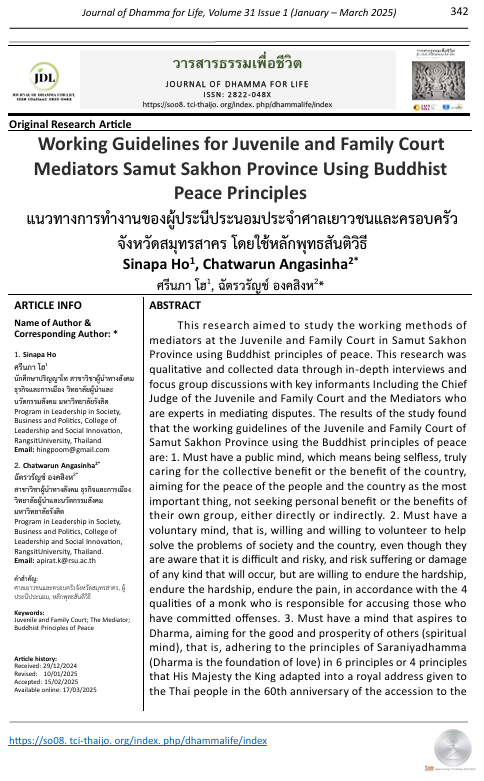Working Guidelines for Juvenile and Family Court Mediators Samut Sakhon Province Using Buddhist Peace Principles
Main Article Content
Abstract
This research aimed to study the working methods of mediators at the Juvenile and Family Court in Samut Sakhon Province using Buddhist principles of peace. This research was qualitative and collected data through in-depth interviews and focus group discussions with key informants Including the Chief Judge of the Juvenile and Family Court and the Mediators who are experts in mediating disputes. The results of the study found that the working guidelines of the Juvenile and Family Court of Samut Sakhon Province using the Buddhist principles of peace are: 1. Must have a public mind, which means being selfless, truly caring for the collective benefit or the benefit of the country, aiming for the peace of the people and the country as the most important thing, not seeking personal benefit or the benefits of their own group, either directly or indirectly. 2. Must have a voluntary mind, that is, willing and willing to volunteer to help solve the problems of society and the country, even though they are aware that it is difficult and risky, and risk suffering or damage of any kind that will occur, but are willing to endure the hardship, endure the hardship, endure the pain, in accordance with the 4 qualities of a monk who is responsible for accusing those who have committed offenses. 3. Must have a mind that aspires to Dharma, aiming for the good and prosperity of others (spiritual mind), that is, adhering to the principles of Saraniyadhamma (Dharma is the foundation of love) in 6 principles or 4 principles that His Majesty the King adapted into a royal address given to the Thai people in the 60th anniversary of the accession to the throne on June 9, 2006, and 4. Must have a rational mind (rational mind), that is, having intelligence, knowing the principles of reason according to the Four Noble Truths, clearly understanding conflicting matters, and being able to explain to the parties involved to see the good and bad results of the conflict in a reasonable and believable manner.


